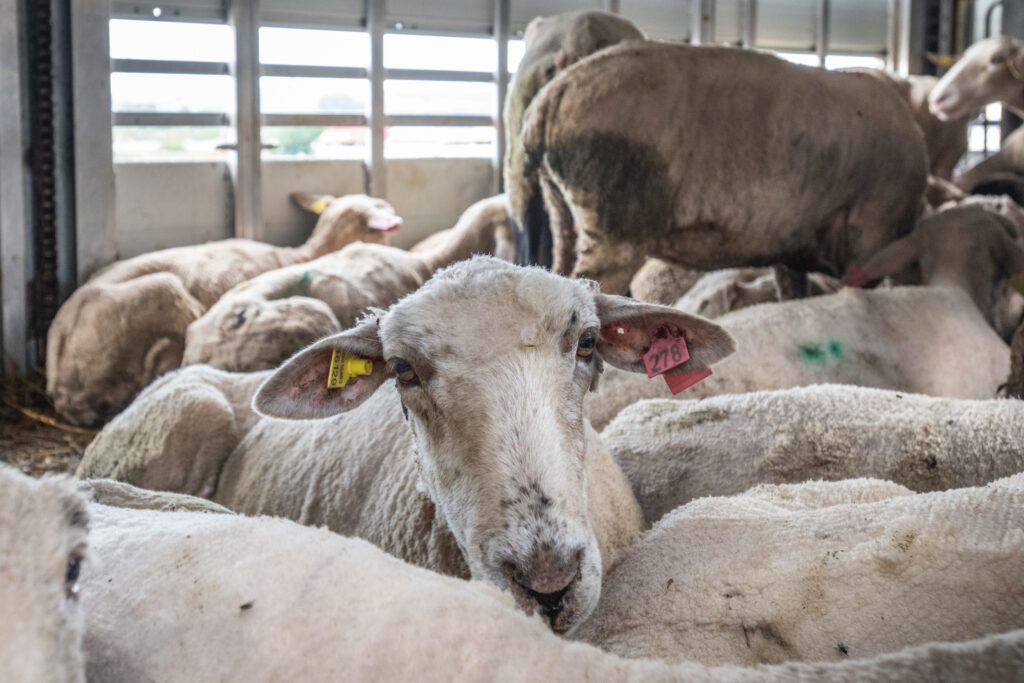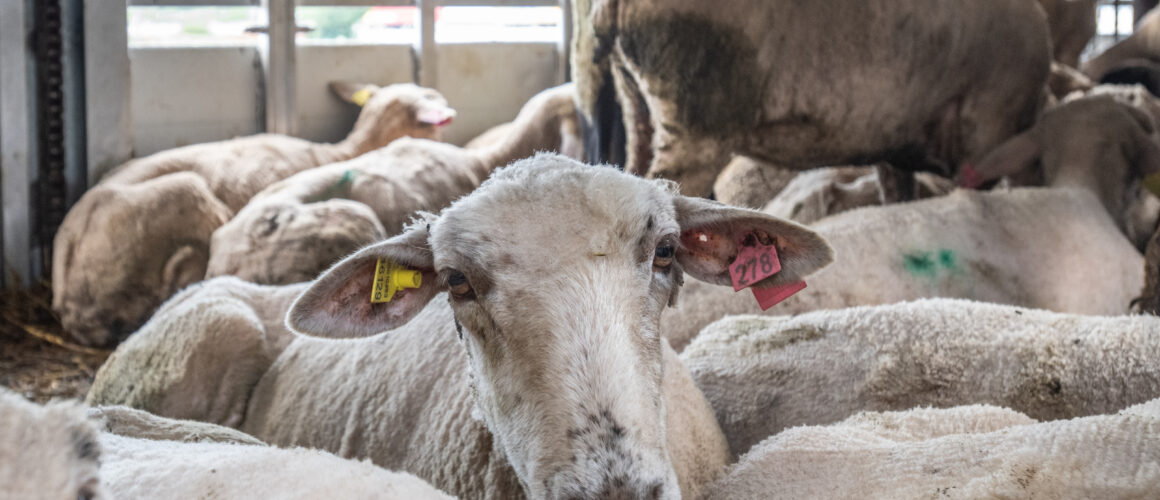Summary
- 231 Australian merino wether sheep were exposed to live export conditions for 21 days.
- The sheep had standing and lying positions recorded before being transported for slaughter.
- The research was funded by Meat and Livestock Australia, LiveCorp and the Australian government.
- Explore the ethical concerns for these sheep kept in live export conditions for animal welfare research. This research may cause suffering to individual animals with minimal species-wide benefits, often reinforcing existing standards rather than advancing animal welfare.
- Read the full research paper and then take action by signing the petition below.
Take Action
Every day that live export continues is another day of suffering for animals. It’s time for Australian politicians to end the cruelty of this trade.
Research Paper
Bonnie T Mayes, Peta S Taylor, Frances C Cowley, John B Gaughan, John M Morton, Brendan P Doyle, L Amy Tait, The effects of stocking density on behavior and biological functioning of penned sheep under continuous heat load conditions, Journal of Animal Science, Volume 101, 2023, skad223, https://doi.org/10.1093/jas/skad223
“The authors declare no conflicts of interest”, and “funders were not involved in study design, collection, analysis, or interpretation of data, or the writing of this article or the decision to submit it for publication”. Although, the funders have “provided constructive criticism” (1) of previous research projects which they have funded.
The study was funded by Meat & Livestock Australia Pty Ltd., LiveCorp, and the Australian Government.
The University of Queensland Animal Ethics Committee under the Animal Care and Protection Act, 2001 (approval ARA 2021/AE000088)
Background
The Livestock Export Program (LEP) is a “collaboration between LiveCorp and Meat & Livestock Australia (MLA), funded by both marketing and research levies” (2) and “seeks to enhance the productivity, sustainability and competitiveness of the livestock export industry” (3).
LiveCorp receives half of its revenue from the Australian Government through fund-matching and has previously conducted “community sentiment” (4) surveys regarding public opinions of the live export trade through Voconiq which is a “CSIRO spin-out company” (5). The CSIRO is an Australian Government agency responsible for scientific research.
“[T]he low consideration of the intrinsic value of animals seems to contradict the history of animal welfare science as well as most accepted scientific concepts of animal welfare.” (15)
The Experiment
The research project involved two hundred and thirty-one merino wethers, aged between 12-18 months, and “randomly allocated to 12 experimental groups of 18 wethers and 15 wethers were retained as spare wethers”. In each group, three (for a total of 36) were randomly selected as “focal wethers”.
The day after arrival at a climate-controlled room in Grattan, Queensland, wethers were split into four groups of 57-58 animals, consisting of one control group and “three experimental groups and three or four spare animals”. They were firstly exposed to an eight day adaption period in which the wethers were fed an increasing percentage of commercial shipper pellet diet. The wethers spent the eight day adaptation period housed at constant thermoneutral conditions with an average wet-bulb temperature of 14.7 °C.
The project then proceeded with a twenty-one day exposure to “relevant voyage climatic conditions and stocking densities”. Twenty-one days is comparable to the length of live export voyages from Australia to the Middle East, and on some occasions has been the length of live export journeys to Indonesia. (6)
During the simulated climactic conditions of a live export journey, the wethers had their standing and lying positions recorded using a sampling approach at hourly intervals over a 24-hour period on days 2, 5, 8, 11, 15, 18, and 20. However, hours 0700, 0800, 0900, 1000, 1400, and 1500 were never recorded.
On the twenty-third day of the experiment, the 36 “focal wethers” began a two-hour transport to “a local abattoir”. A veterinarian performed an autopsy and their diaphragm, heart, lungs, and livers were observed and their condition recorded. Both adrenal glands and the adjacent adipose tissue were then removed and weighed. The remaining non-focal wethers were “returned to the farm from which they originated.” (7)
“Nobody has asked the animal what it requires. Most design is about the ship and not the sheep.” (11)
Discussion
The allometric stocking densities proposed and observed in the project were taken from a 2009 report commissioned by LiveCorp and Meat & Livestock Australia, ‘Space allowances for confined livestock and their determination from allometric principles’. Before the report was finalised and released, the Department of Primary Industries & Fisheries, and Meat and Livestock Australia “provided constructive criticism” of its original findings. (8)
A review of the standards for live export of animals by sea, which includes the recommendations for stocking densities, was undertaken in 2019 (Review of the Australian Standards for the Export of Livestock: Sea Transport) by Dr Michael McCarthy, who was a veterinarian aboard 65 live export voyages for eight major exporters, and had previously conducted “industry-funded research” for LiveCorp and Meat & Livestock Australia. (9) The recommendations state that “for sheep voyages between 1 May and 31 October, the standards require the space allowance to be calculated using a k-value of 0.033”, which is approximately 0.37m2 per animal. (10)
The space allowed to the animals in the current case-study project was “0.030, 0.033, 0.042” for the three groups respectively, or approximately 0.34 m2, 0.37 m2, or 0.48 m2 of pen space for each animal. These sizes were selected based on “various factors, including current industry practices and ensuring the welfare of the animals”, however the researchers noted, “Previous experiments on stocking density identified little difference in behaviour outcomes for sheep with different space allowance” (7).
Live export ships can carry up to 70,000 animals over ten decks. While ventilation systems and airflow are a primary consideration for operators, it may be that they are designed without consideration for the animal’s requirements. “Nobody has asked the animal what it requires. Most design is about the ship and not the sheep.” (11)
As live export ships are made of steel and carry large power, heating, and cooling systems, they generate significant amounts of heat from factors aside from the air temperature (measured as ‘wet-bulb temperature’) or animal temperature. “Up to 60% of the energy supply is lost to the environment”, creating additional heat stress in the immediate environment of the ship, much like a household generator will create heat surrounding the physical space of the appliance. Additionally, “emissions from the shipping currently represent around 2.6% of the total global emissions, but this proportion could more than triple by 2050.” (12) This environmental impact will continue to add environmental heat stressors as the temperatures of the atmosphere increase with time.
Most live export ships leave from Fremantle Port in Western Australia. (13) The Western Australian Department of Primary Industries and Regional Development’s Agriculture and Food division’s recommended floor space for sheep in a confined (albeit, not in transport) area is 2-5m2 per animal. Their disadvantages of confined containment of sheep include, “salmonella, coccidiosis, pulpy kidney, grain poisoning and worms” (14).
“[T]he challenge of identifying the factors present during live export voyages that cause welfare to fall below acceptable standards persists.”

The research paper reviewed in this case study does acknowledge, “the challenge of identifying the factors present during live export voyages that cause welfare to fall below acceptable standards persists. As such, further research is required to determine the cumulative effects of environmental conditions during live export voyages (i.e., air ammonia build-up, and wave motion) and the relationships with thermoregulation and sheep welfare.” However, the author also concludes, “We suggest that it is possible to maintain an acceptable level of sheep welfare with the stocking densities investigated”, despite the inability to apply the stocking densities to a real-world scenario where all environmental factors are considered. It may be that this shortsightedness has led to the suggestions of pen space for animals which do not align with observations, but have still become a primary measure of adequate animal welfare.
Another, albeit obvious, aspect of animal welfare which was not considered in this study is that of the animal’s susceptibility to motion sickness. Similarly to humans, animals have a sensory system which, when in conflict due to differences in body position and movement, can result in motion sickness. This can lead to stress such as restlessness, drooling, and vomiting.
An article published in Animals journal in 2023 found “a neutral or even absent focus on the animals themselves” in 180 randomly selected papers containing an ‘animal welfare’ research objective, such as the paper reviewed here. “[T]he low consideration of the intrinsic value of animals seems to contradict the history of animal welfare science as well as most accepted scientific concepts of animal welfare.” (15) As in the current case study research paper, the animals were considered only in meeting the applied requirements of the industry, not in actively observing or considering the animal’s requirements.
The author, again, acknowledges the study’s shortcomings: “It is important to test how stocking density interacts with these other relevant stressors under hot and humid climatic conditions in future work.”
AFSA Comment
Although AFSA typically profiles the use of animals in biomedical research, we are concerned that farm animal welfare science research can subject individual farm animals to suffering, with limited value for the species, where the research findings simply serve to maintain the status quo for farm animal standards.
Take Action
Every day that live export continues is another day of suffering for animals. It’s time for Australian politicians to end the cruelty of this trade.

1. https://www.sciencedirect.com/science/article/abs/pii/S0168159108002694
2. https://livecorp.com.au/researchAndDevelopment#Current-research-projects
3. https://livecorp.com.au/publication/1hODvGhpqwZzeITK6sgd4u
4. https://livecorp.com.au/report/3t42rgz0OfFfRxzddT6SVl
5. https://voconiq.com/faqs/
6. https://www.agriculture.gov.au/biosecurity-trade/export/controlled-goods/live-animals/live-animal-export-statistics/reports-to-parliament
7. From email correspondence with HRA
8. https://doi.org/10.1016/j.applanim.2008.09.008
9. https://www.agriculture.gov.au/sites/default/files/sitecollectiondocuments/animal/review-asel-sea-transport-final-report.pdf
10. https://www.theguardian.com/world/2018/apr/23/live-exports-review-animal-welfare-groups-criticise-vets-appointment
11. https://maritime-executive.com/editorials/live-export-designing-ships-for-animals
12. https://www.witpress.com/Secure/ejournals/papers/EQ050205f.pdf
13. https://livecorp.com.au/animal-welfare-FAQ/
14. https://www.agric.wa.gov.au/autumn/confined-paddock-feeding-and-feedlotting
15. https://www.ncbi.nlm.nih.gov/pmc/articles/PMC10252133/#B28-animals-13-01833
Images by Jo-Anne McArthur / Israel Against Live Shipments / We Animals Media
